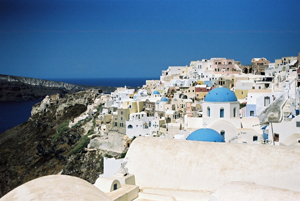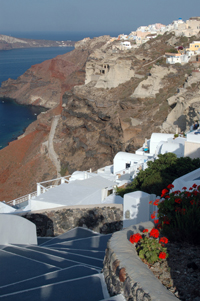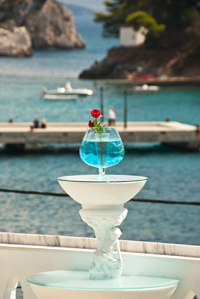Holiday Destinations - Greece
Visit the mainland or one of the many islands for a perfect Greek Holiday
European Travel Destinations – Greece
The capital city of Greece is Athens, it is the birthplace of democracy and has existed for over 3,400 years. It has a population approaching 4 million people if you include the metropolitan areas around the capital. Greece itself has a population of nearly 11 million inhabitants and is famous for the numerous islands that sit off its shores, probably the best known of which from a British tourism perspective is Mykonos, however,the largest island to the south of Greece is Crete. Greece has 13 main regions, Thrace, Macedonia, Epirus, Thessaly, Central Greece, Attica, Peloponnese plus the islands, or groups of islands, Crete, Dodecanese,Cyclades, North Aegean Islands, Sporades Islands and the Ionian Islands.
The Greek Islands are always a big pull for tourists visiting the country, but given the history and culture of one of the most ancient countries in the world there are many amazing sites and places of interest to visit all over Greece which includes the mainland as well as the Islands themselves.
Most Popular Tourist Destinations in Greece
The four most famous villages of Santorini are Oia, Fira, Imerovigli and and Messaria. Just off the coast of Santorini you can also see another little island in the group called Thirassia, it is the only inhabited island of a small chain of islets that were the survivors of the volcanic eruption. It to has traditional white-washed houses in its main village of Horio, which you can reach up a set of something like 250 steps, so not for the faint hearted. Trips to this little sub-island of Santorini are organised during the main summer holiday season and include a look at the volcano and hot springs. Visiting Thirassia from Santorini will give you a view of what the islands were like before tourism changed everything on the main Island of Santorini forever.
Athens, the Acropolis Museum and the Parthenon
Athens, the Acropolis Museum and the Parthenon which sits on top of the Acropolis. These are by no means the only places of interest Athens has to offer but they are the must see places to visit. A trip to Athens would not be complete without making these part of your itinery. If you are into photography the best time to visit the Parthenon is as the sun is going down so you can make best use of the changing light at this time of day.
One of the best preserved ancient Greek temples is the Hephaistion, mainly intact it can be found on the north-west side of the Agora. Built from marble it has served a significant part of its life as a Greek Orthodox church. The other famous Greek temple, located on the north side of the Acropolis, is the Erechtheion which was built a little more than four hundred years BC. This gives you an idea of the very long history of Athens and how important a part Greece plays in the history of Europe.
Another serious place of interest in Athens is the Odeon of Herodes Atticus, a theatre located on the south slope of Acropolis. It is the main venue of the Athens festival which takes place during the summer months starting in May and ending in October.
The Agora is a central place in ancient Greek cities and means a gathering place. The Athens Agora is one of the best examples in Greece and is located north-west of the Acropolis and is believed to have been there probably as early as the 7th century BC with temples dedicated to the Olympian gods, Hephaestus, Zeus and Apollo being added later. The temple dedicated to Hephaestus is still very much standing and is considered, not just the highlight of the Agora, but also one of the must see buildings in Athens.
Delphi
Delphi is a modern town in Greece but is also home to the archaeological site of the Delphi theatre. The theatre was built up a hillside so that it would naturally give audiences a view of the whole sanctuary with the added bonus of a view of what can only be called a spectacular landscape below. Built around the 4th century BC it could hold up to 5000 spectators who would come to enjoy the productions that were put on of mostly plays, poetry and musical events.
Further down the hillside is the temple of Apollo, a Doric temple which was destroyed by an earthquake before being rebuilt around 330 BC. You may be forgiven for thinking it suffered at the hands of another earthquake after that as it is in a fairly ruinous state today, although many of the columns are still standing. It was however the choice of limestone as the building material that was the cause of it’s recent state, as it is quite well known that limestone is a relatively soft material that does not stand the test of many centuries. All the same it still represents an important part of Greek history which can be found on the southern slope of the Parnassos Mountain.
Mykonos
Mykonos this is where Zeus battled the Titans in Greek mythology, but these days the battle is between the nightclubs on this beautiful island that is another from the Cyclades group of islands. The buildings are all white washed in traditional Greek style and the island’s capital Hora has a multitude of narrow marbelled streets brightened by the colourful bougainvillea trees and the contrasting painting of the house’s windows and doors.

The island also has an array of gorgeous beaches, a small harbour with a castle overlooking it. No wonder then that this island is one of the most popular in Greece for holiday makers, especially the younger ones looking for a party atmosphere. Not that the island can’t cater for the more mature and sedate holiday maker, there is nowhere in Greece that isn’t steeped in history and Mykonos is no exception. Little Venice is a district which brings to mind its Italian namesake where you can relax on the waterfront and take in the views of the white-washed windmills set against the blue of the sky and the sea. If you want to avoid all the parties stay in the north, but if partying is what you are looking for head to the south for the beaches, watersports and nightclubs.
The Samaria Gorge
If a walking holiday is what you have in mind for your Greek holiday, then the place to head for is the Samaria Gorge on the island of Crete to the south of the Greek mainland and Greece’s largest island. The gorge is around 10 miles long and runs through forests of cypresses and pine mostly within the National Park of Samaria. It is not open all year, due to high water in winter, but more recently it has been possible to start walking there in April, subject to the state of the paths, or to be absolutely sure May. It closes again at the end of October. It can be both very busy and very hot during the summer, so you may want to decide if those are conditions under which you can truly enjoy the experience. The local recommendation is that spring is the nicest time to do the walk, both for environment you will find yourself in and avoiding the crowds.
The walk starts at an altitude of 1250m and finishes at sea level in Agia Roumeli on the shores of the Libyan sea. It is better to start the walk early in the moring to ensure you miss the mad rush and have time to comfortably finish.
Parga
A personal favourite, this is a small Greek town on the mainland coast towards the north-west of Greece. It is surrounded by mountains full of olive groves and the streets are once again in the traditional Greek white-washed finish, the buildings run up the mountain sides to meet the olive groves and the streets are narrow and colourful. It has a natural bay formed by small islands which are lit up when it gets dark. Sometimes the chuch bell tolls and then you see a little flotilla of boats go out to the island as the local Greeks go to worship.
There is a castle up on the hillside overlooking the sea and you can walk up to it from the main town and then go down the other side to a lovely sandy beach. When you head back to the hotels after a hot day on the beach there is nothing better than stopping at one of the seaside bars to grab a cold beer and sit by the sea looking across what can only be described as a picture postcard view of the sea, the small islands that form the bay and the white-washed church.

There are loads of great restaurants serving traditional Greek fayre of the highest quality, bars and a very busy night life to be had in Parga. The place is jam packed and with nowhere else to go, because of its position at the foot of the mountains, you get a feeling of being secluded from the rest of Greece, even though you are on the mainland. Trust me though, that is not a problem, Parga, as I suggested, has many thousands of tourists of all nationalities and the facilities to cater for them. A bigger problem is when will everyone actually call it a night and provide a little quiet for some sleep. My personal experience was that I got most of my sleep during the day on a nice beach somewhere, especially by opting to take a boat trip out into some of the lovely bays alongside the coastline. Do this and you can enjoy your own private beach for a while and perhaps a lunch of barbecued sardines with salad provided by the trip organiser.
Images courtesy of PhotoXpress
